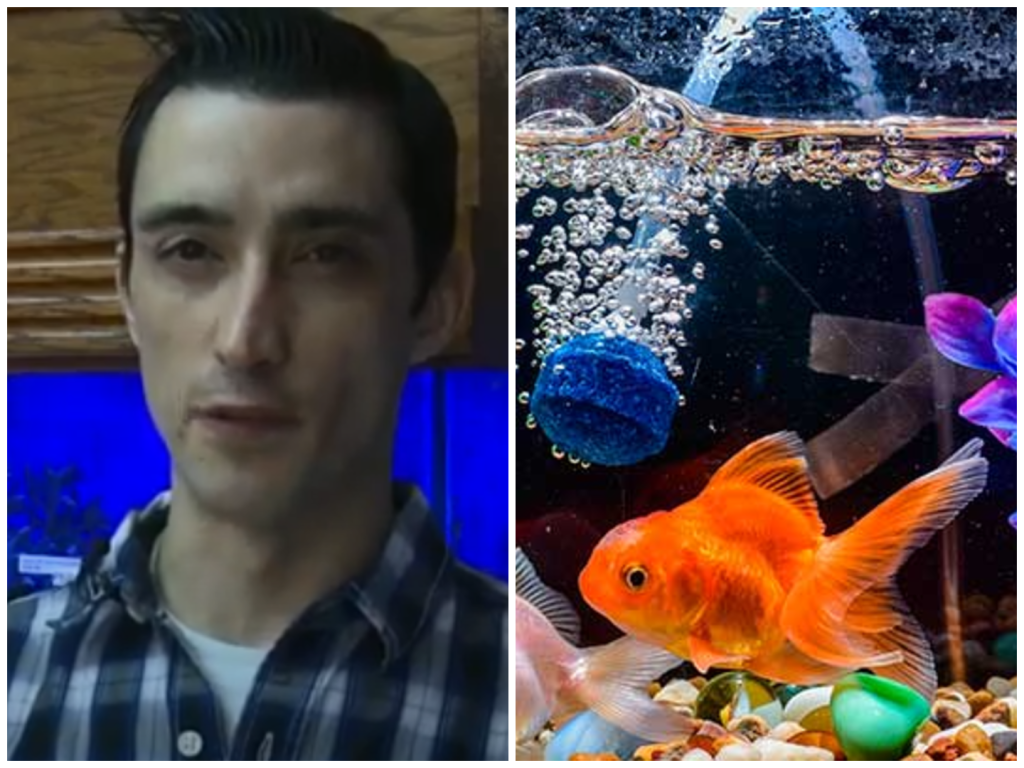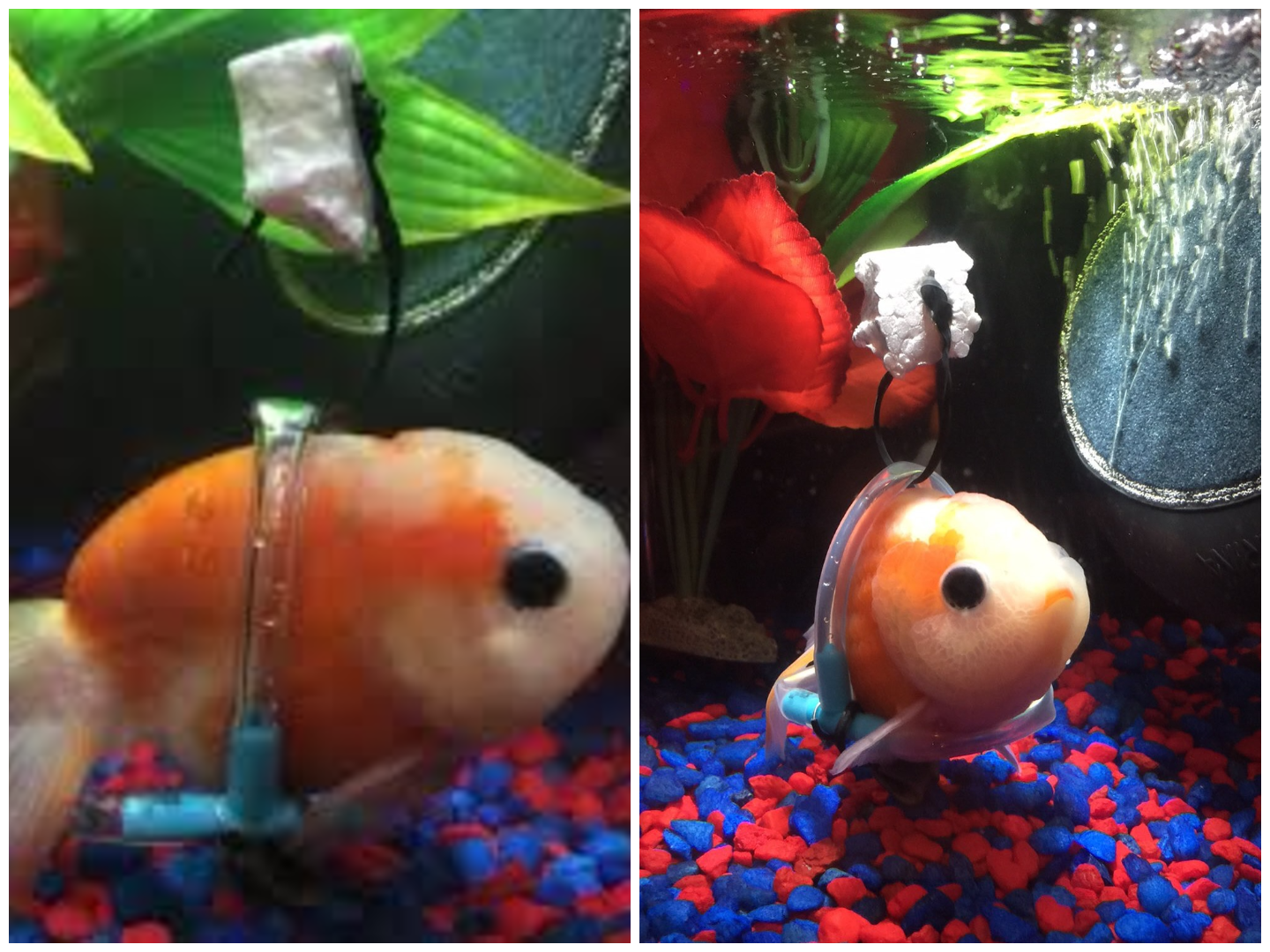Man builds a “wheelchair” for a disabled goldfish that couldn’t stay upright on its own.

Not all heroes wear capes. Some wear aprons and work in quiet aquarium shops, tinkering with plastic tubing and bits of Styrofoam, trying to save a life no bigger than a finger. In 2017, in San Antonio, Texas, a story unfolded that felt like something out of a gentle children’s book—but it was entirely real. At the heart of it was a man named Derek Burnett, and the unlikely star of the tale was a struggling goldfish.
Derek worked as the manager of Aquarium Designs, a local fish and pet shop where people came in to find new companions for their home tanks or to get advice on caring for aquatic life. Over the years, he had seen all kinds of fish—some sick, some injured, some just old and slowing down. But there was something about this particular goldfish that stuck with him.
The fish had developed a common condition known as swim bladder disorder. It’s a frustrating and painful issue that affects a fish’s ability to control its buoyancy. For a goldfish, that often means floating upside down, sinking helplessly to the bottom, or spinning in place without any control. It’s not just a cosmetic issue—it means the fish is in distress, struggling every moment just to stay upright.
Most people wouldn’t know how to help, and even if they did, they might not go through the trouble. A fish, after all, is small and quiet. It doesn’t cry out. It doesn’t ask for help. But Derek saw it differently. He didn’t see a disposable pet. He saw a creature that deserved a chance—just like any living thing.
So he got to work.
Using materials he found right there in the store, Derek started experimenting. He grabbed some airline tubing—the kind used to keep oxygen flowing in fish tanks—and began building a kind of support harness. He added a few tiny valves for structure and then zip-tied them gently around the fish’s body to make sure it stayed snug without causing discomfort. The trickiest part was getting the buoyancy right. Too much weight and the fish would sink. Too much lift and it would just bob at the surface. So he added small pieces of Styrofoam in the perfect spot, balancing the fish like you’d balance a fragile ornament.
It wasn’t an overnight fix. It took adjustments, patience, and heart. But eventually, it worked.
The goldfish, once stuck floating awkwardly on its side, was now upright. It could swim again—maybe not as fast or as gracefully as before, but it could move. It could explore. It could breathe a little easier. Derek had built the aquatic equivalent of a wheelchair, and it made all the difference.
When the story spread online, people were stunned—not because the technology was groundbreaking, but because the act was so simple and kind. In a world full of noise and conflict, here was a man who used an hour of his day and some plastic tubing to give a goldfish its life back. It reminded people that compassion doesn’t need to be loud. Sometimes, it’s quiet, creative, and deeply personal.
Derek didn’t expect to go viral. He didn’t do it for views or attention. He did it because it felt like the right thing to do. And that’s what made the story resonate. The image of that small, floating goldfish, held steady by a harness built by human hands, is unforgettable. It’s the kind of thing that makes you pause and reevaluate what kindness really looks like.
This story also shines a light on how we treat animals that don’t bark or meow. Fish are often seen as decoration—something to look at, not something to care about deeply. But this moment flipped that idea on its head. It showed that empathy doesn’t need to be earned by sound or size. Life is life, no matter how small, and it’s worth protecting if we can.
The fish, thanks to Derek’s invention, lived out its days in comfort. It swam again. It felt the water glide past its fins and the pebbles beneath its belly. And for that little fish, the world became a little less heavy. All because one person took the time to look closer, think differently, and believe that even a goldfish deserves dignity.
This story isn’t just about fish. It’s about the kind of world we want to build. One where no life is too small to matter. One where kindness is action, not just intention. One where something as tiny as a bit of tubing and a piece of foam can become a symbol of love.

Daniel Reed is a curious mind with a passion for breaking down how the world works. With a background in mechanical engineering and digital media, he turns complex ideas into easy-to-understand articles that entertain and inform. From vintage tools and modern tech to viral internet debates and life hacks, Daniel is always on the hunt for the “why” behind the everyday. His goal is simple: make learning feel like scrolling through your favorite feed — addictive, surprising, and fun.
